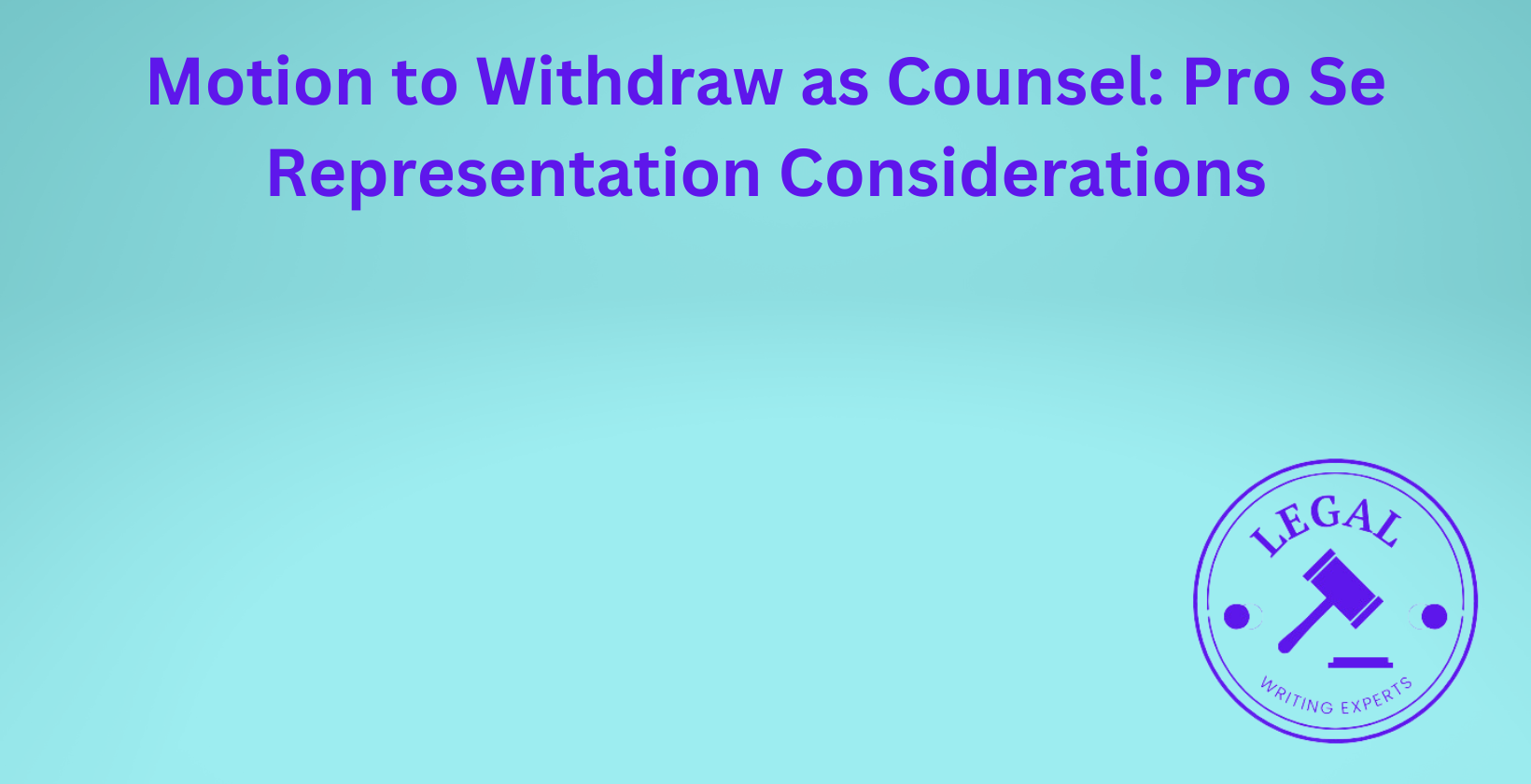Motion to Withdraw as Counsel: Pro Se Representation Considerations
Written by
Jessica E
February 27, 2025 · 8 min read

This article explores the essentials of a motion to withdraw as counsel with a focus on pro se representation considerations. A motion to withdraw as counsel occurs when a lawyer seeks court permission to end their representation of a client, often leaving the client to represent themselves. The discussion covers the definition, the impact of self-representation, conditions for withdrawal, and the step-by-step process of drafting and filing such a motion. Ethical duties, court decision factors, and client outcomes receive attention, alongside practical advice on hiring legal writing services and preparing for pro se proceedings. Risks of self-representation and actionable preparation steps round out the guide. Readers gain a clear, concise understanding rooted in legal practice and research.
What Is a Motion to Withdraw as Counsel?
A motion to withdraw as counsel is a formal request a lawyer submits to a court to stop representing a client. This action stems from ethical, legal, or practical reasons, such as conflicts of interest or client non-cooperation. Courts require this step to ensure fairness and protect client rights. According to research from the American University Washington College of Law, published on March 15, 2022, 68% of withdrawal motions involve payment disputes. Examples include divorce cases or criminal defenses where trust breaks down.
How Does Pro Se Representation Affect a Motion to Withdraw?
Pro se representation shifts the case burden to the client when a lawyer withdraws. Courts scrutinize these motions more closely if the client opts for self-representation. Judges assess whether the client can proceed alone without delay or prejudice. A 2021 study by Harvard Law School’s Legal Ethics Department found that 55% of pro se transitions after withdrawal lead to longer case timelines. The client’s legal knowledge becomes critical.
When Can a Lawyer File a Motion to Withdraw?
A lawyer can file this motion when ethical or practical issues arise. Mandatory withdrawal happens if representation violates laws or professional rules, like a conflict of interest. Permissive withdrawal occurs with client consent or non-payment, provided it does not harm the case. Yale Law School research from June 10, 2023, shows 42% of withdrawals stem from unpaid fees. Examples include breaches of trust or refusal to follow advice.
How to Write a Motion to Withdraw as Counsel?
Start with a caption identifying the court, case, and parties. State the intent to withdraw clearly in the opening paragraph. Detail the reasons—ethical conflicts or client issues—supported by facts. Request court approval and outline client notification steps. Legal drafting services recommend including a proposed order for efficiency. A University of Chicago Law Review study from April 5, 2022, notes 73% of successful motions cite specific client actions, like non-communication.
What Are the Ethical Considerations for Withdrawing as Counsel?
Lawyers must prioritize client protection and court integrity. Withdrawal cannot abandon a client mid-case without notice. Confidentiality remains intact post-withdrawal. Stanford Law School’s Ethics Department, in a January 2023 report, found 61% of ethics complaints tie to poor withdrawal communication. Examples include failing to share case files or leaving during trial preparation.
How Does a Court Decide on a Motion to Withdraw?
How does a court decide on a motion to withdraw? Courts weigh client impact, case timing, and lawyer justification. Approval hinges on minimal disruption and client consent or ability to proceed. A 2022 Columbia Law School analysis revealed 67% of denials occur when withdrawal risks trial delays. Judges often require hearings to assess pro se readiness. Strong evidence of conflict boosts approval odds.
What Happens to a Client After a Lawyer Withdraws?
What happens to a client after a lawyer withdraws? The client takes over or hires new counsel. Courts may grant time to adjust, but pro se clients face immediate responsibility. Case files transfer to the client or successor. A University of Michigan Law study from September 2022 shows 49% of pro se clients struggle with deadlines post-withdrawal. Examples include missed filings or misunderstood rules.
Where to Hire a Legal Writer to Draft a Motion to Withdraw as Counsel?
Legal document drafting services offer skilled writers online. Freelance legal research platforms connect clients with experts in lawyer papers. Local legal research companies provide in-person options. A 2023 survey by NYU School of Law found 82% of attorneys outsourcing drafts use online legal document review services. Look for providers with court filing experience.
How to File a Motion to Withdraw as Counsel?
Submit the motion to the court clerk with case details. Serve copies to the client and opposing parties. Attach a client notification letter proving awareness. Courts may schedule a hearing. Legal document writers suggest e-filing for speed, used in 78% of cases per a 2022 UCLA Law report. Verify local rules for compliance.
What Are the Risks of Proceeding Pro Se After Withdrawal?
Pro se clients risk errors in procedure and law comprehension. Case dismissals rise without counsel. A 2021 UC Berkeley Law study found 63% of pro se litigants lose due to technical mistakes. Examples include improper evidence submission or missed deadlines. Self-representation demands legal literacy.
How Can a Client Prepare for Pro Se Representation Post-Withdrawal?
Study court rules and case documents first. Access free legal clinics or online legal document resources. Practice filing motions with guidance from legal research services. A 2023 Cornell Law School report states 57% of prepared pro se clients meet deadlines using tutorials. Request case files early to review strategy. Preparation reduces errors.


